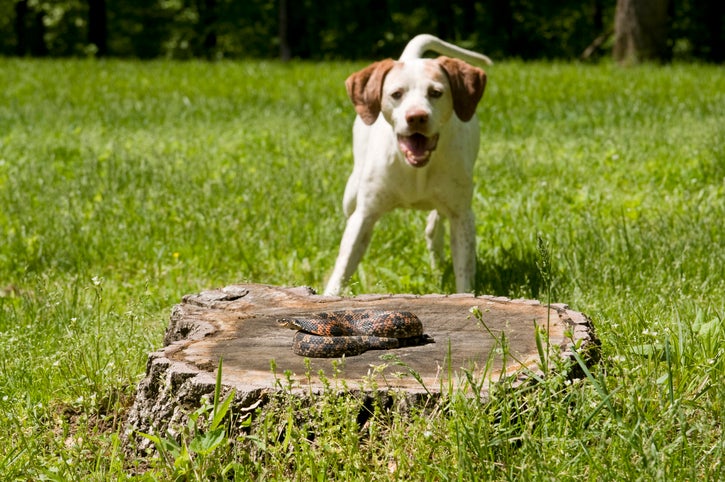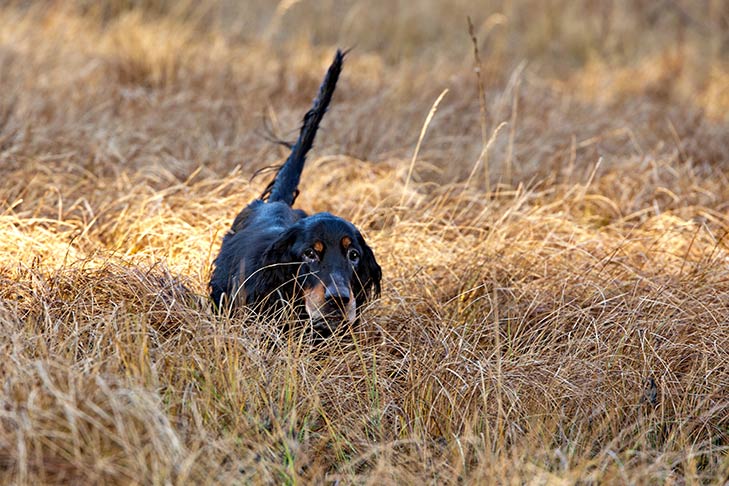
While lions, tigers, and bears aren’t a problem for many pet owners, there are plenty of other wild animals that can pose a significant threat to your dog. From porcupines to rattlers, here are some of the creatures that require caution for the safety of your dog.
Dogs and Porcupine Quills
Anyone who has seen a dog after a porcupine attack can understand why these animals are so dangerous — their super sharp quills can end up in a pet’s throat, nose, and eyes, which typically requires surgery to remove. The average cost of this surgery according to experts is $370. Worse, an attack from a porcupine can be fatal if their quills spark a severe infection.
Porcupines typically live in wooded areas throughout the northern and western states. Keeping your dog on a leash in areas like these can help you both avoid a nasty encounter. If your dog must be off leash, a strict recall and leave it cue may also help, but we all know these are not something to be trusted if your dog is really intent on seeking out the animal.
Something you may not know about porcupines is that they climb trees and will make their dens under and around houses in wooded areas. If your dog is getting attacked in your wooded backyard, then it’s time to “proof” your home against the unwanted guest. Keep pet food and garbage cans inside the garage or in a shed. Since their main food source is tree bark and buds, if you have trees in your yard, they can attract porcupines. At this point, you may have to set a steel live-animal trap to catch the creature and have it relocated to a more remote area.
Dogs and Coyotes
The truth? Coyotes eat small animals including pint-size pets like Chihuahuas and Russel Terriers. While brutal attacks on much larger dogs are less frequent, it happens especially if a coyote feels threatened. A coyote proof fence combined with motion sensor lights, which spook wild animals at night, can help protect your dog while in your yard. Any dog runs should have a cover over them, so a coyote cannot climb over, and the fence should be buried in the ground at least a foot so they cannot dig under.
If you have a dog that needs to be let off-leash, buying them a spiked vest that is made for coyote attacks is a great idea. Remove any water or food sources from your yard, this includes putting your grill away, which smells like meat. Even bird feeders are known to attract coyotes; a coyote will eat the seeds as well as the birds and rodents they attract. Have sparse vegetation in your yard so there is nowhere for the coyote to hide.
In areas with a large coyote presence, it is best not to leave your dog outside unattended — even during the day. That’s because coyotes are not strictly nocturnal.

Dogs and Snakes
Venomous snakes such as copperheads and rattlers are dangerous to people and to dogs. The type you need to watch for depends on where you live. The most critical thing you need to know is that snakes strike quickly. A few preventive measures can keep your dog out of harm’s way.
If you live alongside rattlers, the rattlesnake vaccine for canines could be a lifesaver. Keeping your dog on a leash is another excellent way to keep him safe. In order for both you and your dog to enjoy your own yard peacefully, there are some things you can do to make your yard less inviting to snakes. First, you should know there is no smell or taste that can keep snakes out – this means the idea of using mothballs to repel snakes is an old wives’ tale. Snakes can’t smell and they taste their prey, that’s about it.
The main way to keep snakes out of your yard has to do with your landscape. Keep your grass cut as short as possible, limiting cover. Trim trees and bushed up off the ground. Other places snakes like to hide include piles of rocks, bricks, lumber, wood, etc. Get rid of any natural snake habitats. Immediately pick up and haul out debris piles. Small wire fencing, where the squares are no wider than a quarter of an inch, buried at least one foot in the ground and standing at least three foot tall, can also help keep snakes out of a yard. Be sure there are no gaps at any joints. Block off the underneath of your house with the same fencing.
Also, remember they are probably coming to your yard for prey, so removing prey, removes the snake. This means eradicating any rodent problems and not setting out birdfeeders to attract birds.
Depending on your own level of comfort, and your dog’s, you can also invite non-poisonous snakes that prey on poisonous ones to live in your yard. Gopher snakes are very territorial and will fight off other snakes. Kingsnakes may be large and scary looking, but they actually kill and eat rattlesnakes.
Dogs and Raccoons
These furry scavengers will fight to protect their access to garbage and other food sources. Smaller dogs will be more at risk than larger ones, but any size pet can get injured by their sharp teeth and claws. Just as unsettlingly, raccoons are one of the top carriers of the rabies virus in the United States.
What can you do? Raccoons are nimble climbers, which makes them tough to keep out of yards. You would have to have almost a prison-grade fence. They are dumpster divers, so store garbage cans and other food sources in sheds and garages. If you have to leave your cans out, use bungee cords to secure them. Like the other animals on this list, removing bird or squirrel feeders is also a good idea, as raccoons have no problem snacking on seeds. Secure attics, as many raccoons make nests in them.
A motion sensing light will also help scare them off at night, as they are nocturnal. You can also try a motion sensing water sprayer, for some raccoons this works, others do not seem to care. If nothing else, it will alert you that something is out there. You can also try trapping and relocating.
Dogs and Skunks
Skunk spray is not just stinky — it causes nausea, vomiting and burning in the eyes. The weird thing is, some dogs can’t resist these striped creatures no matter how times they get sprayed in the face. Keeping your dog on a leash is the only sure-fire way on a walk to keep your dog from running off and getting nailed.
If you live out in a semi-rural or farm area, you may have skunks that come into your yard. Again, remove food sources: garbage cans, pet food, bird feeders, etc. and any water sources. A nocturnal animal, motion sensing lights help scare skunks off as well. Secure the areas under porches and any crawl spaces under your house, as these are places skunks love to use as dens. Skunks can dig, so burying your fence at least a foot is a must. They are not good climbers, however, so a super tall fence is not usually required, three-feet is fine.

